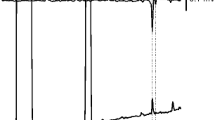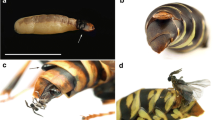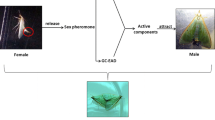Abstract
The lepidopteran genus Saturnia has three representatives in North America, S. walterorum, S. mendocino, and S. albofasciata. (E4,Z9)-Tetradecadienal (E4,Z9–14 : Ald) was identified as a sex pheromone component for all three species by combinations of coupled gas chromatography–electroantennogram detection (GC-EAD), GC–mass spectrometry (MS), and field trials. In field trials, all three species were strongly attracted to (E4,Z9–14 : Ald) as a single component. Small amounts of (Z)-9-tetradecenal (Z9–14 : Ald) also were found in extracts of all three species, but blends of this compound with E4,Z9–14 : Ald were no more attractive to male moths than E4,Z9–14 : Ald alone. Extracts of pheromone glands of female S. walterorum occasionally contained a third, trace compound eliciting responses from male antennae in GC-EAD experiments, but this compound was not identified. It is suggested that the three species can use the same, single component as a sex attractant because the flight period of S. albofasciata (fall) is different than that of the other two species (spring), whereas the geographic distributions of S. mendocino and S. walterorum overlap over only small portions of their ranges. Furthermore, the latter two species readily hybridize, so there may be minimal fitness cost to cross-attraction.
Similar content being viewed by others
REFERENCES
BESTMANN, H.-J., KOSCHATSKY, K. H., and VOSTROWSKY, O. 1982. Stereoselektive Synthesen von 1,5-und 1,6-Alkadienen als Sexualpheromone und Pheromonanaloge. Liebigs Ann. Chem.1982:1478-1498.
BESTMANN, H.-J., ATTYGALLE, A. B., BROSCHE, T., ERLER, J., PLATZ, H., SCHWARZ, J., VOSTROWSKY, O., WU, C.-H., KAISSLING, K. E., and CHEN, T.-M. 1987a. Identification of three sex pheromone components of the female saturniid moth Antheraea pernyi(Lepidoptera: Saturniidae). Z. Naturforsch.42c:631-636.
BESTMANN, H.-J., WU, C.-H., DOHLA, B., LI, K., and KAISSLING, K.-E. 1987b. Functional group recognition of pheromone molecules by sensory cells of Antheraea polyphemusand Antheraea pernyi(Lepidoptera: Saturniidae). Z. Naturforsch.42c:435-441.
BROWN, C. A., and AHUJA, V. K. 1973. P-2 nickel catalyst with ethylenediamine, a novel system for highly stereo-specific reduction of alkynes to cis-olefins. J. Chem. Soc. Chem. Commun.1973:553-554.
COLL, J. C., and BOWDEN. B. F. 1986. The application of vacuum liquid chromatography to the separation of terpene mixtures. J. Nat. Prod.49:934-936.
COREY, E. J., and SUGGS, J. W. 1975. Pyridinium chlorochromate. An efficient reagent for oxidation of primary and secondary alcohols to carbonyl compounds. Tetrahedron Lett.1975:2647-2650.
DU, G., NG, C.-S., and PRESTWICH, G. D. 1994. Odorant binding by a pheromone binding protein: Active site mapping by photoaffinity labelling. Biochemistry33:4812-4819.
DUCOUX, J.-P., LE MENEZ, P., KUNESCH, N., KUNESCH, G., and WENKERT, E. 1992. An efficient and stereoselective synthesis of insect pheromones by way of nickel-catalyzed Grignard reactions. Syntheses of gossyplure and pheromones of Eudia pavoniaand Drosophila melanogaster. Tetrahedron48:6403-6412.
HERSCOVICI, J., EGRON, M.-J., and ANTONAKIS, K. 1982. New oxidative systems for alcohols: molecular sieves with chromium-(VI) reagents. J. Chem Soc. Perkin Trans. I1982:1967-1973.
HUMASON, G. L. 1972. Animal Tissue Techniques, 3 ed. W. H. Freeman and Company. San Francisco.
KAISSLING, K.-E., and THORSON, J. 1980. Insect olfactory sensilla: Structural, chemical and electrical aspects of the functional organization, pp. 261-282, D. B. Sattelle, L. M. Hall, and J. G. Hildebrand (eds.), inReceptors for Neurotransmitters, Hormones, and Pheromones in Insects, Elsevier/North Holland Biomedical Press, New York.
KOCHANSKY, J., TETTE, J., TASCHENBERG, E. F., CARDé, R. T., KAISSLING, K.-E., and ROELOFS, W. 1975. Sex pheromone of the moth Antheraea polyphemus. J. Insect. Physiol.21:1977-1985.
MARQUES, F. A., MCELFRESH, J. S., and MILLAR, J. G. 2000. Kovats retention indexes of monounsaturated C12, C14, and C16 alcohols, acetates, and aldehydes commonly found in lepidopteran pheromone blends. J. Braz. Chem. Soc.11:592-599.
SHARMA, S., SABHARWAL, A., VOHRA, N., SHARMA, M. L., VIG, O. P., and KAD, G. L. 1990. Syntheses of the sex pheromone components of wild silk moths, fruit fly, melon fly, and olive fly. J. Indian Chem. Soc.67:31-33.
SONNET, P. E. 1974. A practical synthesis of the sex pheromone of the pink bollworn. J. Org. Chem.39:3793-3794.
STILL, W. C., KAHN, M., and MITRA, A. 1978. Rapid chromatographic technique for preparative separations with moderate resolution. J. Org. Chem.43:2923-2925.
TOMIDA, I., IWAKOSHI, K., KONO, S., TAKAHASHI, T., MATSUNAGA, T., and KAYAHARA, H. 1987. Flutter-stimulating activities on male Eri-silk moths, Philosamia cynthia ricini, for four geometric isomers of 4,9-tetradecadienyl formate. Agric. Biol. Chem.51:939-940.
TUSKES, P. M., and COLLINS, M. M. 1981. Hybridization of Saturnia mendocinoand S. walterorum, and phylogenetic notes on Saturnia and Agapema (Saturniidae). J. Lepid. Soc.35:1-21.
TUSKES, P. M., TUTTLE, J. P., and COLLINS, M. M. 1996. The Wild Silk Moths of North America: A Natural History of the Saturniidae of the United States and Canada. Cornell University Press, Ithaca, New York.
Author information
Authors and Affiliations
Rights and permissions
About this article
Cite this article
Mcelfresh, J.S., Millar, J.G. & Rubinoff, D. (E4,Z9)-TETRADECADIENAL, A SEX PHEROMONE FOR THREE NORTH AMERICAN MOTH SPECIES IN THE GENUS Saturnia. J Chem Ecol 27, 791–806 (2001). https://doi.org/10.1023/A:1010310204552
Issue Date:
DOI: https://doi.org/10.1023/A:1010310204552




